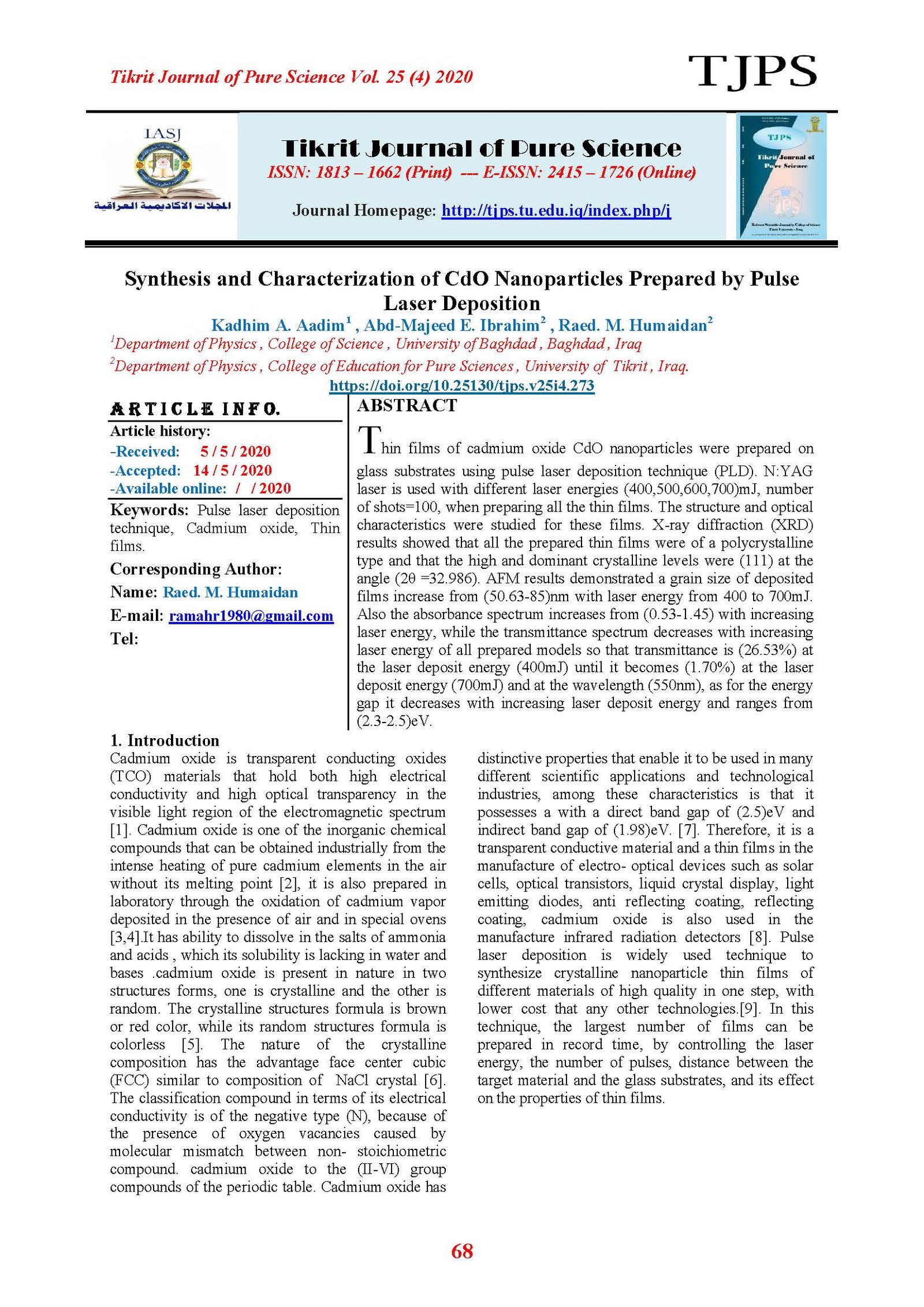Synthesis and Characterization of CdO Nanoparticles Prepared by Pulse Laser Deposition
Main Article Content
Abstract
Thin films of cadmium oxide CdO nanoparticles were prepared on glass substrates using pulse laser deposition technique (PLD). N:YAG laser is used with different laser energies (400,500,600,700)mJ, number of shots=100, when preparing all the thin films. The structure and optical characteristics were studied for these films. X-ray diffraction (XRD) results showed that all the prepared thin films were of a polycrystalline type and that the high and dominant crystalline levels were (111) at the angle (2θ =32.986). AFM results demonstrated a grain size of deposited films increase from (50.63-85)nm with laser energy from 400 to 700mJ. Also the absorbance spectrum increases from (0.53-1.45) with increasing laser energy, while the transmittance spectrum decreases with increasing laser energy of all prepared models so that transmittance is (26.53%) at the laser deposit energy (400mJ) until it becomes (1.70%) at the laser deposit energy (700mJ) and at the wavelength (550nm), as for the energy gap it decreases with increasing laser deposit energy and ranges from (2.3-2.5)eV.
Article Details

This work is licensed under a Creative Commons Attribution 4.0 International License.
Tikrit Journal of Pure Science is licensed under the Creative Commons Attribution 4.0 International License, which allows users to copy, create extracts, abstracts, and new works from the article, alter and revise the article, and make commercial use of the article (including reuse and/or resale of the article by commercial entities), provided the user gives appropriate credit (with a link to the formal publication through the relevant DOI), provides a link to the license, indicates if changes were made, and the licensor is not represented as endorsing the use made of the work. The authors hold the copyright for their published work on the Tikrit J. Pure Sci. website, while Tikrit J. Pure Sci. is responsible for appreciate citation of their work, which is released under CC-BY-4.0, enabling the unrestricted use, distribution, and reproduction of an article in any medium, provided that the original work is properly cited.
References
[1] Hames, Y and San, S.E. (2004). CdO/CuO2 solar cells by chemical deposition. solar energy, 77(3):291-294.
[2] Chu, T.L and Chu, S.S. (1990). Degenerate cadmium oxide films for electronic devices .Journal of Electronics Materials , 19(9) : 1003-1005.
[3] Jarzberzki, Z. M. (1973). oxide semiconductors. 1st edn., London: Pergamon Press:285pp.
[4] Chopra, K. L. and Das. S.R.(1993). Thin films Solar Cells. 3th edn., New York: Plenu Press:607pp.
[5] Jefferson, P.H. (2008). Band gap and effective mass epitaxial cadmium oxide. Applied Physics Letters , 92(2 ), 022101.
[6] Cotton ,F.A. et al. (1999). Advance inorganic chemistry . 6th edn ., New York : John Wiley and Sons:1376pp.
[7] Yufanyi, D. M.et al.(2014). CdO Nanoparticles by thermal decomposition of a cadmium hexamethylenetetramine complex. Journal of Materials Science Research, 3(3):1-11.
[8] Ohring ,M.(2001). Materials science of thin films . New York., Academic press:794pp .
[9] Zeng ,H. et al.(2012).Nanomaterial's via laser ablation/irradiation in liquid: A review. Advance Function Materials,22(7):1333-1353.
[10] Salem, E. T.(2006). Pulsed laser deposition of some TCO films for
optoelectronic applications. Ph.D. thesis, Technology University, Baghdad, Iraq:200pp.
[11] Rajesh, N.(2016). microwave and synthesis of CdO and SnO2 nanostructure and comparison of structure, optical and dielectric properties. International Journal of Engineering Applied Sciences and Technology, 1(10): 9-18.
[12] Zaien, M.et al. (2013). Fabrication and characterization of an n-CdO/p-Si solar cell by thermal evaporation in a vacuum. International Journal of Electrochemical Science,8:6988-6996.
[13] Al-ansari, R. A.et al. (2017). Study of physical properties of CdO thin film prepared by chemical spray pyrolysis technique. Diyala Journal for pure Sciences, 13(40):91-105.
[14] Thi. L. L. (2016). Preparation of transition metal oxide thin films used as solar absorbers. Ph. D .thesis , University Toulouse 3 Paul Sabatier, France:217pp.
[15] Ahmad, R.A et al. (2019). Synthesis and characterization of CdO1-x ZnOx for solar cells application. Digest Journal of Nanomaterial's and Biostructures, 14(1): 15 – 22.
[16] Hanan. R.A. (2016). Effect of substrate temperature on structural and optical properties of CdO thin films. Tikrit Journal of Pure Science 21 (3):121-142 .
[17] Hasan ,N. B; Mohammed, G. H. and Abdul Majeed, M.A.(2015). Structural and optical properties of (CdO)1-x(SnO2)x thin films prepared by pulsed laser deposition. International Letters of Chemistry, Physics and Astronomy , 59: 62-71.
[18] Abdulridha,W. M.(2016).Synthesis and study the structure and optical properties of CdO polycrystalline thin film using electrochemical depositing method, International Journal of Nanomaterial's and Chemistry, 2(1): 21-25 .
[19] Yang. E. S.(1988). Microelectronic devices. 2th edn., McGraw-Hill, New York:464pp.
[20] Zhng, J.Z. (2009). Optical properties and spectroscopy of nanomaterial's .4th edn., World Scientific Publishing Company:383pp.
